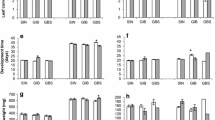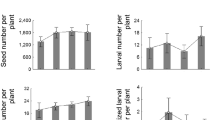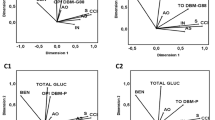Abstract
The relative activities of 10 glucosinolates in stimulating oviposition byP. rapae andP. napi oleracea were compared under the same conditions. When tested at the same concentration, the structurally different glucosinolates stimulated both butterfly species to widely varying degrees. In most cases,P. rapae was more sensitive to aromatic and indole glucosinolates than to aliphatic representatives. This species responded even less to alkyl thio and sulfinyl glucosinolates. However,P. napi oleracea responded strongly to these aliphatic and sulfur-containing members of the group, and the relative activities of aromatic and aliphatic glucosinolates did not show a clear pattern for this species.P. napi oleracea was much more sensitive to low concentrations of sinigrin than wasP. rapae. The threshold concentration for response ofP. napi oleracea to sinigrin was 10−8 M, which was 100 times lower than forP. rapae, butP. rapae was more sensitive thanP. napi oleracea to changes in glucosinolate concentrations. For bothPieris species, an optimal concentration was reached, above which the response remained constant or tended to decrease.
Similar content being viewed by others
References
Chew, F.S. 1977a. Coevolution of pierid butterflies and their cruciferous foodplants. II. The distribution of eggs on potential foodplants.Evolution 31:568–579.
Chew, F.S. 1977b. The effects of introduced mustards (Cruciferae) on some native north American cabbage butterflies (Lepidoptera: Pieridae).J. Xerces Soc. 5:13–19.
Daxenbichler, M.E., Spencer, G.F., Carlson, D.G., Rose, G.B., Brinker, A.M., andPowell, R.G. 1991. Glucosinolate composition of seeds from 297 species of wild plants.Phytochemistry 30:2623–2638.
Dethier, V.G. 1982. Mechanisms of host-plant recognition.Entomol. Exp. Appl. 31:49–56.
Feeny, P. 1977. Defensive ecology of the cruciferae.Ann. Mo. Bot. Gard. 64:221–234.
Hagerup, M., Søndergaard, I., andNielsen, J.K. 1990. Measurements of areas consumed from leaf discs by chewing phytophagous insects: Descriptions of a new method involving image processing.Entomol. Exp. Appl. 57:105–113.
Huang, X.P., andRenwick, J.A.A. 1993. Differential selection of host plants by twoPieris species: The role of oviposition stimulants and deterrents.Entomol. Exp. Appl. 68:59–69.
Huang, X.P., Renwick, J.A.A., andSachdev-Gupta, K. 1993a. A chemical basis for differential acceptance ofErysimum cheiranthoides by twoPieris species.J. Chem. Ecol. 19:195–210.
Huang, X.P., Renwick, J.A.A., andSachdev-Gupta, K. 1993b. Oviposition stimulants and deterrents regulating differential acceptance ofIberis amara byPieris rapae andP. napi oleracea.J. Chem. Ecol. 19:1645–1663.
Huang, X.P., Renwick, J.A.A., andSachdev-Gupta, K. 1994. Oviposition stimulants inBarbarea vulgaris forPieris rapae andP. napi oleracea: Isolation, identification and differential activity.J. Chem. Ecol. 20:423–438.
Jackson, F.L.C. 1991. Secondary compounds in plants (allelochemicals) as promoters of human biological variability.Annu. Rev. Anthropol. 20:505–546.
Louda, S., andMole, S. 1991. Glucosinolates: chemistry and ecology, pp. 123–164,in G.A. Rosenthal and M.R. Berenbaum (eds.). Herbivores, Vol. I. Academic Press, New York.
Miller, J.R., andStrickler, K.L. 1984. Finding and accepting host plants, pp. 127–157,in W.J. Bell and R.T. Cardé (eds.). Chemical Ecology of Insects. Sinauer Associates, Sunderland, Massachusetts.
Nielsen, J.K. 1978. Host plant discrimination within Cruciferae: Feeding responses of four leaf beetles (Coleoptera: Chrysomelidae) to glucosinolates, cucurbitacins and cardenolides.Entomol. Exp. Appl. 24:41–54.
Nielsen, J.K. 1989. The effects of glucosinolates on responses of youngPhyllotreta nemorum larvae to non-host plants.Entomol. Exp. Appl. 51:249–259.
Nielsen, J.K., Kirkeby-Thomsen, A.H., andPetersen, M.K. 1989. Host plant recognition in monophagous weevils: specificity in feeding responses ofCeutorhynchus constrictus and the variable effect of sinigrin.Entomol. Exp. Appl. 53:157–166.
Renwick, J.A.A., andRadke, C.D. 1988. Sensory cues in host selection for oviposition by the cabbage butterfly,Pieris rapae.J. Insect Physiol. 34:251–257.
Renwick, J.A.A., Radke, C.D., Sachdev-Gupta, K., andStädler, E. 1992. Leaf surface chemicals stimulating oviposition byPieris rapae (Lepidoptera: Pieridae) on cabbage.Chemoecology 3:33–38.
Richards, O.W. 1940. The biology of the small white butterfly (Pieris rapae), with special reference to the factors controlling its abundance.J. Anim. Ecol. 9:243–288.
Rodman, J.E., andChew, F.S. 1980. Phytochemical correlates of herbivory in a community of native and naturalized Cruciferae.Biochem. Syst. Ecol. 8:43–50.
Sachdev-Gupta, K., Radke, C.D., andRenwick, J.A.A. 1992. Chemical recognition of diverse hosts byPieris rapae butterflies. Proc. 8th Intl. Symp. Plant-Insect Relationships, Wageningen, pp. 136–138.
Traynier, R.M.M., andTruscott, R.J.W. 1991. Potent natural egg-laying stimulant for cabbage butterflyPieris rapae.J. Chem. Ecol. 17:1371–1380.
Van Loon, J.J.A., Blaakmeer, A., Griepink, F.C., van Beek, T.A., Schoonhoven, L.M., andde Groot, A. 1992. Leaf surface compound fromBrassica oleracea induces oviposition byPieris brassicae.Chemoecology 3:39–44.
Verschaffelt, E. 1910. The cause determining the selection of food in some herbivorous insects.Proc. Acad. Sci. Wet., Amsterdam 13:536–542.
Author information
Authors and Affiliations
Rights and permissions
About this article
Cite this article
Huang, X., Renwick, J.A.A. Relative activities of glucosinolates as oviposition stimulants forPieris rapae andP. napi oleracea . J Chem Ecol 20, 1025–1037 (1994). https://doi.org/10.1007/BF02059739
Received:
Accepted:
Issue Date:
DOI: https://doi.org/10.1007/BF02059739




